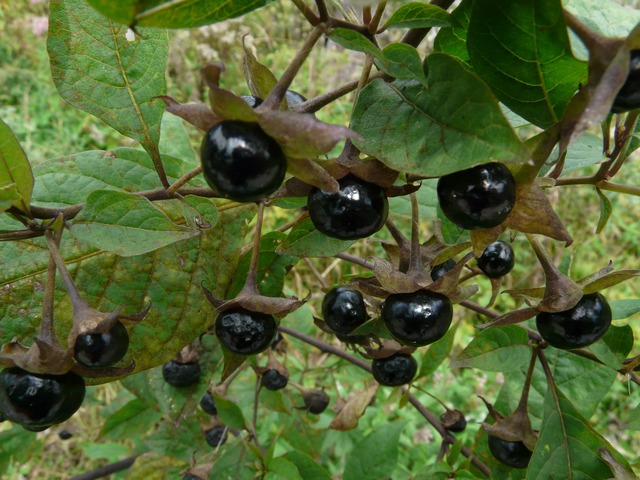 |  |  |   |  |
  |
Belladonna, also known as deadly nightshade, has a multi-headed rhizome with numerous thick, branched roots. The succulent, branched, and robust stems reach heights of 0.5 to 2 meters and are covered with dense dark green foliage. At the top, the stems divide into three branches, which then further branch forked or in a false whorl. The plant has entire, petiolate, glabrous leaves; the lower leaves are alternate, while the upper ones are paired closely. Large leaves can reach up to 22 cm in length and 11 cm in width, while smaller leaves are about 7.5 cm long and 3.5 cm wide. Of the two paired leaves, one is always significantly larger than the other; typically, the larger leaves are elliptical and pointed, while their paired counterparts are smaller and ovate.
The flowers, located in the leaf axils, are nodding, solitary, fairly large, five-parted, bell-shaped, actinomorphic, with a double perianth. They have a brownish-purple corolla measuring 20-30 mm in length and 14-20 mm in width. The calyx is five-toothed, and the corolla has five reflexed lobes with five stamens. The floral formula of belladonna is *K5C5A5G(2).
The fruit of belladonna is a black, shiny, juicy, multi-seeded berry about the size of a cherry. It has a sweet-sour taste but is poisonous, as is the entire plant. Belladonna blooms from June to August, with fruiting starting in July.
Raw Material Harvesting
In medicine, the leaves, herb, and roots of belladonna are used as medicinal raw materials. In warm climates with proper care, belladonna plantations can be used for more than 5 years. During the summer, leaves are harvested 2 to 5 times and dried in dryers. Leaves of wild belladonna are collected manually. At the beginning of flowering, the lower leaves are gathered before the stem branches, closer to the end of flowering – from young branches, and then during seed formation, the plant is mowed at a height of 10 cm from the ground. The mowed herb is cut into pieces up to 4 cm long and then dried. Roots are dug up in autumn, washed, cut into pieces 10-20 cm long, split lengthwise if necessary, and dried.
Thus, three grades of raw material are obtained: leaves (pharmacopoeial raw material), chopped herb (used in galenic production), and roots (used in galenic production, sometimes for extracting atropine). Leaves and herb are dried quickly in special dryers at 40°C, while roots are dried in the air. The crop is cultivated in the same place for 5-6 years. The storage period for leaves is 2 years, and for roots – 3 years.
Chemical Composition
The alkaloids, mainly atropine and hyoscyamine, are found in the roots (4%), leaves (0.14–1.2%), stems (0.2–0.65%), flowers (0.24–0.6%), and ripe fruits (0.7%). The leaves of belladonna also contain scopolamine (hyoscine), apotropine, belladonin, as well as volatile bases such as N-methylpyrroline, N-methylpyrrolidine, and pyridine, along with flavonoids and oxycoumarins. The roots contain the alkaloid cuscohygrine.
Pharmacological Properties
The main alkaloid contained in belladonna, atropine, dilates the pupil by blocking the M-cholinergic receptors of the circular muscle of the iris. It also suppresses the secretion of almost all glands of the gastrointestinal tract (salivary, gastrointestinal, pancreatic), sweat glands secretion, and relaxes the smooth muscles of the bronchi and stomach. Large doses of atropine can cause motor and psychological excitation by affecting the cerebral cortex.
